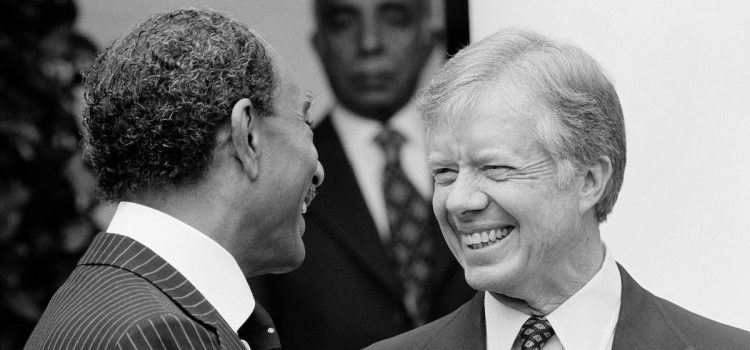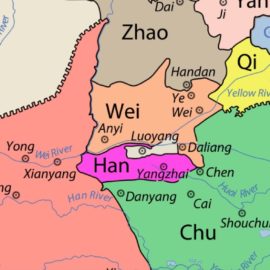

This article is an excerpt from the Shortform book guide to "His Very Best" by Jonathan Alter. Shortform has the world's best summaries and analyses of books you should be reading.
Like this article? Sign up for a free trial here.
How did Jimmy Carter’s political career start? What are some of the defining moments that shaped his career and formed his legacy?
Biographer Jonathan Alter takes us on a journey through Jimmy Carter’s political career that starts well before his presidency. Alter discusses what drew Carter to politics in the first place, and he describes the various stops on the winding road that ended at the White House.
Read more to learn about Carter’s career from the Georgia State Senate to the US presidency.
Jimmy Carter’s Political Career
Jimmy Carter’s political career has its root in the dominant hardline conservatism of his hometown of Plains, Georgia. Feeling hampered in such an environment, Carter felt drawn to the political world where he might sway policies in a direction that aligned with his more progressive values.
In 1962, a landmark Supreme Court case (Baker v. Carr) forced a restructuring of legislative districts that opened a path for political moderates like Carter to seek office in rural, conservative regions of the country. Nevertheless, to win the backing of voters beyond the circle of his small-town connections, Carter would have to straddle the line between liberals and conservatives. Alter describes how Carter rose to office through a series of political victories and losses that led him to redefine his Christian faith on the way to becoming governor of Georgia.
(Shortform note: In Baker v. Carr, the Supreme Court ruled that states must periodically redraw legislative districts to be equivalent to the population represented. Prior to Baker v. Carr, Georgia’s districts gave more representative power to conservative rural counties than to liberal urban centers like Atlanta. The Supreme Court ruling didn’t alter liberal or conservative Georgians’ political leanings, but in his memoir Turning Point, Carter explains that redrawing the lines threw many incumbents out of their seats as their districts no longer existed. The vacuum this created allowed political newcomers like Carter the chance to get their foot in the door if they acted quickly.)
Carter as State Senator
Carter won a seat in the Georgia State Senate during the 1962 elections. But, to do so, he had to keep silent on his views about racial equality. Instead, he would place his focus on improving education for all throughout the state. Alter writes that Carter put on a conservative facade, with the exception of his stance favoring the separation of church and state. Unlike other senators, Carter spent many long nights reading every bill that came before him while eschewing the political hobnobbing that would have ingratiated him with his colleagues.
(Shortform note: When describing Carter’s early political career, Alter paints him as a political chameleon—someone who hides their own political views to conform with group expectations. Studies show that many people behave this way to avoid discomfort in social situations, though when politicians do it, it’s often perceived as ethically questionable “pandering” for votes. Some research suggests that politicians don’t pander to public opinion as much as people think they do, but voters are likely to perceive a politician as pandering if they’re a member of the opposing party or if their stance on an issue is inconsistent.)
Carter for Governor
In 1966, midway through his term in the Senate, Carter set his sights on running for governor on a more progressive platform. He lost to Lester Maddox, a conservative Democrat who was strongly in favor of maintaining Georgia’s racial segregation. Alter states that Maddox’s win was more than a blow to Carter’s ambitions—it also shook his Christian faith. Carter couldn’t understand why God would grant victory to someone as openly racist as Maddox.
(Shortform note: Prior to 1966, Georgia restaurant owner Lester Maddox had never won a political race, but he’d earned national notoriety for his racist views. In 1965, Maddox was arrested and acquitted for forcing three black students out of his restaurant at gunpoint—an act that made him a hero to people opposed to the Civil Rights Movement. Because the Georgia constitution didn’t allow governors to serve two consecutive terms in office, Maddox wasn’t eligible to run for reelection in 1970 when Carter would make his next attempt.)
Carter had always been devoutly Christian, but it was only after his loss to Maddox that he studied theology in depth. It was during this time that Carter says he was truly “born again,” though Alter says it wasn’t a flash of insight but a slow, transitional period in which Carter connected with others through his faith. Taking part in mission trips, Carter learned the value of compassion, particularly for the suffering of those he met in person. Carter felt that to live by his Christian values, he’d have to fight harder for social justice.
Carter Runs Again
In 1970, Carter made his second bid for governor of Georgia. This time he would display a willingness to use his everyman background to his advantage and then throw his political advantage away in the name of doing what he felt to be right. Alter explains that Carter played both sides of Georgia’s racial divide to secure his election, then pivoted on his first day in office to take a strong integrationist stance.
Carter had to keep his political rhetoric far enough to the right to win conservative votes but not so far that he’d turn away liberals. He avoided issues of race in his campaign by framing the discussion as one about class, education, and government spending. For two years before the election, Carter drummed up support door-to-door, reaching out to segregationists and the Black community at the same time. Alter claims that, while Carter never took an overtly racist stance, he used “dog whistles” to hint to racist voters that he was on their side, inadvertently pioneering a strategy that other politicians would hone to perfection over the following decades.
(Shortform note: Named after literal dog whistles, which are pitched so high that humans can’t hear them, a political “dog whistle” is a coded message that has a loaded meaning for one group of people while sounding innocuous to others. For instance, a candidate might complain about inner-city crime, which white suburbanites might easily understand to refer to African-American crime. In Dog Whistle Politics, Ian Haney López discusses how both Republican and Democratic politicians have used such techniques to garner votes by exaggerating fears and resentments among races, religions, and different social classes.)
However, during Carter’s 1971 inaugural address, he shocked his supporters and opponents alike by announcing that the segregation era must end. This immediately angered his conservative backers who now felt they’d been lied to all along. Alter acknowledges the view of some liberals that Carter should have come out in support of civil rights much sooner than he did, but Alter makes the point that, if Carter had, his career would have died on the vine.
Meanwhile, the fact that a Southern governor had spoken in favor of racial integration made national headlines and introduced Carter to the US at large. In office as governor, Carter immediately began appointing African-Americans to state office. He pushed his promised education platform, which now included integrating schools, and he was the first Georgia governor to commemorate civil rights leaders with portraits in the state capitol. Alter writes that despite Carter’s anti-segregation policies, he was still deeply tied to his identity as a Southerner. However, Carter believed the South had to grow beyond its racist past if it was ever to move forward into the future.
Carter for President
Just as he eyed the governorship while serving in the Georgia State Senate, Carter turned his ambitions to the presidency while serving his term as governor. Carter’s homespun values of honesty and integrity came as a breath of fresh air in the cynical 1970s and made his longshot candidacy a viable bid for the White House. Carter leveraged the disillusionment voters felt after the Watergate scandal to present himself as a Washington outsider—an honest man of faith who’d restore the nation’s dignity. Coupled with strategic campaigns in crucial regions of the country, this strategy would win Carter a narrow victory over incumbent President Gerald Ford.
Distrust of government was at an all-time high, which Carter saw as a nationwide emotional crisis. His public reaction to Watergate was one of disappointment instead of anger, and he campaigned on the message that honesty in government was what the country needed most. Carter’s humble background and genial charm cast him as former President Nixon’s opposite. Voters were drawn to Carter’s status as an outsider to national politics, as well as to his promise not to lie to the American public. Alter says that the latter was a stretch—Carter did exaggerate on occasion, and because of his promise, the media held him to a higher standard of truthfulness than his opponents.
Despite the fact that Carter made a point of separating politics and religion while governor, he opened up about his Christianity on the presidential campaign trail while still affirming his belief in church and state separation. He framed his faith in terms of love and compassion for all, which came as a balm to many Americans weary from scandals and the war in Vietnam. Alter points out that Carter was the first presidential candidate to identify as Evangelical, a religious group who were just beginning to coalesce as a political force—and who, after Carter, would switch their allegiance to the Republican Party.
Carter was not the early favorite to win the Democratic nomination, but strategic victories in early state primaries earned him press coverage and national recognition. The US’s political parties weren’t as polarized during this time as they are today, so Carter was able to straddle the liberal/conservative divide by taking progressive stances on racial equity, the environment, and even gay rights while aligning with conservatives on business issues and wasteful government spending. Alter argues that adopting a middle-road stance let Carter win the Democratic nomination without really energizing the party as a whole.
The general election came down to the wire. In the end, Carter won the popular vote by only two percentage points, and the electoral college vote was close as well. Carter’s identity as a Southerner helped him carry that region despite his work towards ending segregation, though Alter suggests that Carter’s win reconfigured the Democratic party by bringing an end to its conservative wing. After 1976, the American South would consistently back Republican candidates in all following elections.
Alter says that, because Carter had no driving political ideology, he was free to focus on the country as a whole without being beholden to any particular interest groups. Unfortunately, since Carter won by such a narrow margin, his power base would be shaky going forward. Carter had the advantage of a Democratic congress, but during an era when congressmen didn’t strictly vote along party lines. Over the next four years, Carter would attempt to lead the country using logic and practicality, not force of personality. To the consternation of his staff and advisors, he would stubbornly pursue whatever he felt were the right policy decisions without considering the political blowback from his choices.
President Carter the Reformer
Carter had campaigned on a promise to correct the course of government, and as soon as he entered office he put that promise into action. Though many of his choices proved unpopular in the short term, Alter contends that Carter enacted many governmental improvements that remain undervalued in the common narrative of his presidency. The lasting changes Carter implemented involved reshaping the administration of the executive branch, taking steps to address US energy policy, and bringing diversity to the judiciary.
The most dramatic alterations Carter made to the executive branch were to redefine the roles of the Vice President (VP) and First Lady. Carter positioned VP Walter Mondale as a full partner, including him in all presidential briefings and placing him second in the military chain of command. Carter also included Rosalynn in all briefings and cabinet meetings—except those for which she didn’t have a security clearance—and regularly consulted her before making important decisions of state. Finally, he overturned convention by empowering his cabinet members over White House staff, whom he treated in much the same demanding way that his father and Admiral Rickover had treated him—expecting excellence without praise.
The US that Carter inherited was in the midst of steep inflation and gas shortages brought about in part by a reliance on foreign oil. Carter spent his first 100 days in office shaping his National Energy Plan, which he didn’t sugarcoat for the public when he described the energy crisis as an existential threat to the country. The legislation that Carter passed through Congress produced short-term hardships in the form of higher energy costs while curbing inflation in the long run. Carter’s plan also resulted in the creation of the Department of Energy, which would oversee future energy research and conservation efforts.
A bill passed in 1978 added 152 judicial positions, which Carter used as an opportunity to bring diversity to the court system. He convinced the Senate Judiciary Committee to create an independent commission for nominations, which he then directed to specifically look for minority candidates. In total, Carter appointed more judges than any other president, and his appointees included African-Americans, Hispanics, and women—most notably Ruth Bader Ginsburg, who would later serve on the Supreme Court. Alter suggests that if Carter had had the opportunity to appoint a Supreme Court justice, he would have nominated the first woman to serve. Despite that, Carter successfully reshaped the judiciary in favor of diversity and equality.
President Carter the Diplomat
On the global stage, Carter distinguished himself as a president who would eschew the use of military strength except as a last resort. Instead, he prioritized maintaining and promoting peace at any cost, including political damage to himself. While Carter’s presidency included dramatic successes such as averting a military crisis in the Panama Canal and negotiating a lasting peace between Israel and Egypt, his legacy was ultimately marred by his response to the Iranian Revolution and the subsequent hostage crisis, which we’ll discuss in a later section.
Alter writes that Carter was determined to do the right thing regardless of the political consequences. A prime example of this was giving Panama control of the Panama Canal, which by treaty belonged to the US forever. Perpetual American control of the canal bred anti-US resentment in Panama and neighboring countries that threatened to erupt into violence. Had it done so, the US would have been forced to defend the canal and all the traffic through it in a conflict that might have eclipsed the Vietnam War in scope and duration. Presidents Johnson, Nixon, and Ford had all broached the topic of transferring ownership of the canal to Panama, but it had been blocked by fierce congressional opposition.
Carter’s fellow politicians considered any attempt to give away the canal to be tantamount to political suicide, but Alter says that Carter viewed indefinite US control to be morally unjust to the Panamanian people. Carter hashed out a new deal with Panama, and to get it ratified by the Senate, he framed it as two separate treaties—one ensuring that the canal would remain open and neutral, and another handing over control of the canal to Panama in 1999. The neutrality treaty passed by one vote, and Carter spent a lot of political capital to make sure the handover treaty passed as well. Though giving away the canal proved unpopular in the US, it protected a vital global trade route and kept the US out of another costly war.
The Camp David Accords
Another conflict where Carter felt compelled to intervene was that between Israel and its Arab neighbors. Though open fighting halted in 1973, Egypt and Israel were still technically at war, and thousands of Palestinians lived in refugee camps. Carter valued Israel because of his religious convictions, but Alter says Carter sympathized with the Palestinians, whom he felt were enduring the same conditions that his Black neighbors had during segregation. He reached out to Middle Eastern leaders in the hopes of brokering a lasting peace and connected strongly with Egyptian President Anwar Sadat. Carter hosted talks between Sadat and Israel’s prime minister Menachem Begin at Camp David, the presidential retreat outside Washington.
Over two weeks of intense negotiations, Carter mediated between the two leaders, doing everything he could to produce an agreement. Alter explains that, just as with Panama, Carter arrived at a two-treaty solution—one to ensure Israel’s withdrawal from Egypt’s Sinai Peninsula and one to restrict Israel’s presence in the West Bank while talks continued toward Palestinian independence. While the latter never came to fruition, the peace between Egypt and Israel has held since the Camp David Accords were accepted.
The Iran Hostage Crisis
While Carter was achieving a measure of success negotiating peace between Israel and Egypt, the political situation in Iran was deteriorating faster than anyone in the US realized. The Iranian Revolution and the 444-day hostage crisis that followed would become for many people the defining historical event of Carter’s presidency, completely dominating his last year in office. Alter details the road to the crisis, Carter’s resistance to using military force, and the final push to free the hostages just as Carter’s presidency came to its end.
In Iran, Ayatollah Khomeini gained a following as a fierce critic of Mohammad Reza Shah, Iran’s dictator since 1953, but the CIA never saw Khomeini as a serious threat to world peace. In 1978, the Shah’s health began failing, and Khomeini’s supporters launched violent protests to demand the Shah’s removal. Alter writes that when the Shah asked the US for aid to prop up his regime, Carter refused, believing that without a dictator, Iran would return to democratic rule. Suffering from cancer, the Shah went into exile in January 1979 to seek medical treatment abroad while Khomeini amassed power in his country.
Alter argues that there was nothing Carter could have done to prevent the Shah’s downfall or Khomeini’s rise to power, but he notes that Carter was taken aback by the strength of anti-US sentiment in Iran. So as not to stoke that anger—and to protect US citizens still in Iran—Carter repeatedly denied the Shah entry into the US until October 1979, when he was told that the Shah would die without treatment at an American hospital. Giving in to his humanitarian values, Carter granted the Shah temporary medical asylum. The Iranian response was stronger than anyone expected.
The Hostages Are Taken
Islamist groups within Iran believed the Shah’s presence in the US was part of a scheme to return the Shah to power. On November 4, 1979, under Khomeini’s direct approval, Iranian students stormed the US embassy in Tehran looking for evidence of a plot against Iran, taking the staff as prisoners in what was meant to be a short occupation. A rescue was unfeasible since Tehran was so far from US military forces. More than that, Carter feared that any attack would result in hostage deaths while dragging the US into another war. Carter placed sanctions on Iranian oil, froze Iranian bank accounts within the US, and made one attempt at a military rescue that failed because of the US military’s inability to coordinate between branches.
Within Iran, Khomeini used his control of the crisis to establish himself as the head of a constitutional theocracy while not allowing hostage negotiations to take place unless the Shah was returned to stand trial for alleged crimes against the Iranian people. Once it was clear that Carter wasn’t going to retaliate, Khomeini knew he could hold the hostages indefinitely. At home, the hostage crisis brought the American people together while painting Carter as an ineffective leader. Alter states that this was also the US public’s first introduction to radical Islam.
The Hostage Crisis Ends
Carter devoted nearly all his focus to resolving the hostage situation, attempting to negotiate through other countries as intermediaries instead of campaigning hard for reelection. Even the Shah’s death in June 1980 didn’t bring about the hostages’ release. Instead, Alter suggests that two other factors caused Khomeini to finally relent. One was Iraq’s invasion of Iran under the command of Saddam Hussein—suddenly, Iran needed access to the funds that were frozen in US bank accounts. The second factor was a fear that Carter’s electoral opponent, Ronald Reagan, wouldn’t share Carter’s hesitation to use military force if he won the election.
Thanks to Carter’s divided attention, the state of the economy, and the crisis in Iran, Reagan won a landslide victory. Nevertheless, Carter’s work wasn’t finished. In the final days of his presidency, Carter, at last, brokered a deal for the hostages’ freedom, though Khomeini delayed their release until Reagan took the oath of office. President Reagan announced the end of the crisis while Carter and Mondale flew to Germany to greet the freed captives in person. Although the public had turned against Carter, Alter reiterates that the president had kept the US out of war throughout all four years of his term, a feat unmatched by any following president.

———End of Preview———
Like what you just read? Read the rest of the world's best book summary and analysis of Jonathan Alter's "His Very Best" at Shortform.
Here's what you'll find in our full His Very Best summary:
- A fresh perspective on Jimmy Carter's time as president
- How Carter's early life shaped his political career
- The long-term effects of what Carter accomplished while president






